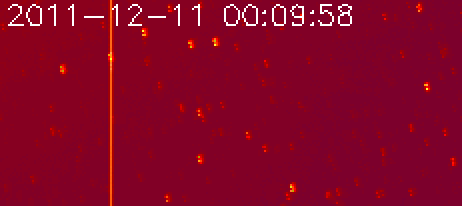Don't just watch shooting stars. Wear them! Authentic meteorite jewelry for Christmas is now available in the SpaceWeather Store. | | |
GEMINID METEOR SHOWER: The Geminid meteor shower peaks on Dec. 13th and 14th. Bright moonlight will interfere with the display, but not obliterate it. Forecasters expect observers with clear skies to see as many as 40 meteors per hour. The best time to look, no matter where you live, is between 10 pm local time on Tuesday, Dec. 13, and sunrise on Wednesday, Dec. 14th. [full story] [meteor radar] [meteor app] [sky map] [Geminid images: #1]
SIGNIFICANT COMET PLUNGES TOWARD THE SUN: A comet nearly as wide as two football fields (200m) is plunging toward the sun where it will most likely be destroyed in a spectacular light show on Dec. 15/16. Although Comet Lovejoy (C/2011 W3) could become as bright as Jupiter or Venus when it "flames out," the glare of the sun will hide the event from human eyes. Solar observatories in space, however, will have a grand view. Yesterday the brightening comet entered the field of view of NASA's STEREO-B spacecraft:

"You can clearly see the comet heading diagonally through the images," says Karl Battams of the Naval Research Lab who prepared the animation. "During the 16-hour sequence, the comet brightens from magnitude +8 to +6.5, approximately."
It will soon grow much brighter. "This comet is a true sungrazer, and will skim approximately 140,000 km (1.2 solar radii) above the solar surface on Dec. 15/16," notes Battams. At such close range, solar heating will almost certainly destroy the icy interloper,creating a cloud of vapor and comet dust that will reflect lots of sunlight. The Solar and Heliospheric Observatory (SOHO) will have a particularly good view.
Discovered on Dec. 2nd by amateur astronomer Terry Lovejoy of Australia, the comet is an unusually large member of the Kreutz family. Kreutz sungrazers are fragments of a single giant comet (probably the Great Comet of 1106) that broke apart back in the 12th century. SOHO sees one plunging into the sun every few days, but most are small, no more than 10 meters wide. Comet Lovejoy is at least ten times larger than usual.
more images: from Jan Ebr of Malargue, Argentina; from Ernesto Guido, Giovanni Sostero & Nick Howes using a remote controlled telescope in Australia
AURORA WATCH: A solar wind stream is buffeting Earth's magnetic field, causing mild geomagnetic disturbances and auroras around the Arctic Circle. "Last night, Dec. 12th, we went out to see the meteor shower, but the Moon was too bright," says Helge Mortensen of Kvaløya, Norway. "Instead of Geminids, we got the Northern Lights." Not a bad consolation prize:

The chances of auroras mixing with meteors will increase on Dec. 13/14 as the Geminid meteor shower intensifies and the solar wind continues to blow. Arctic photographers are encouraged to target the heavens on Tuesday night. Images may be submitted here. Aurora alerts: text, phone.
more images: from Frank Olsen of Tromsø, Norway
Dec. 10th Total Lunar Eclipse Gallery

